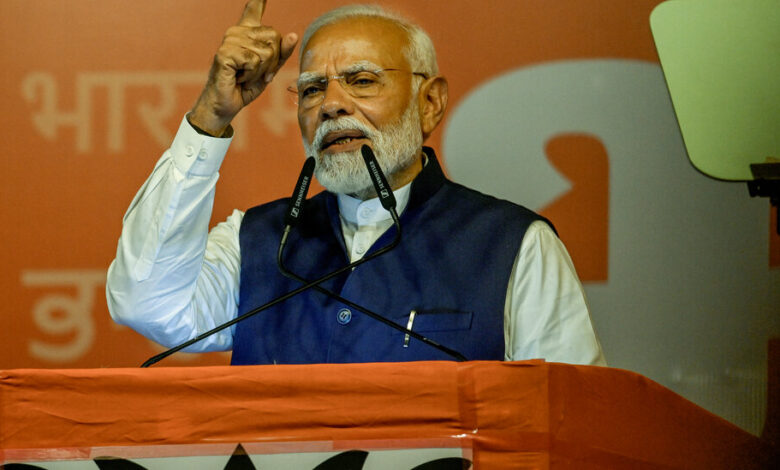Lessons learned from the 2024 election in India: Modi strives to maintain his lead

Narendra Modi’s first decade as India’s prime minister was full of surprises. However, nothing like what happened on Tuesday morning when he was re-elected for a second time, but lost his party’s majority in Parliament.
With that defeat, Mr. Modi’s air of invincibility also seemed to fade for the first time since he took office in 2014.
The election results were especially shocking because after nearly seven sweaty weeks of voting across the country, exit polls released just days before the final count showed that his Bharatiya Janata Party Modi will win resoundingly as he did twice before.
Instead, the Bharatiya Janata Party won only 240 seats, far short of the 272 needed to form a government. The opposition alliance led by the Indian National Congress holds 235 seats.
With 52 seats won by the BJP’s allies, Modi will continue to lead. But his appeal has waned and his leadership has fundamentally changed.
Modi’s air of invincibility has been punctured.
When Modi came to power in 2014, he promised to achieve economic progress, end corruption and promote Hinduism as central to India’s identity. Through it all, he showed himself to be a uniquely strong leader, capable of mobilizing his followers to work for the nation.
This is in contrast to the previous government. Before Modi was first elected, India had spent 25 years being ruled by coalitions. Prime ministers from the Congress Party, the BJP and smaller third parties take turns running India by committee. Mr. Modi broke with that tradition, leading a new one-party system dominated by the BJP
As a leader, Mr. Modi shows little interest in sharing power. When he invalidated most of India’s banknotes in 2016, even his finance minister did not know about the decision in advance. When he decided to impose de facto martial law on Jammu and Kashmir, India’s only Muslim-majority state, he presented the plan to Parliament as a deal that had been done without need permission.
But that time has passed.
The two largest parties that emerged as the BJP’s new alliance partners are led by N. Chandrababu Naidu and Nitish Kumar, veteran lawmakers known as technocratic moderates. Both are likely to demand greater powers in Parliament. In fact, both are seen as potential candidates for the prime minister’s post, if there is another alliance led by both the BJP and the Congress.
India’s political map was remade overnight
When the first national electoral maps showing seats won and lost in Congress were revealed on Tuesday, they revealed a remarkable new pattern.
Maps show Modi’s party has lost swathes of territory across the northern Hindi-speaking states that were considered strongholds of the BJP.
At the same time, the BJP has made inroads into areas that have opposed Modi in the past. He lost dozens of seats in the northern state of Uttar Pradesh, but won many seats in the eastern state of Odisha and this state. southern states of Telangana.
The only part of the country that now looks unified by one party is the “tribal belt,” which stretches across the central states. Its relatively poor communities have been cleverly targeted by the BJP and its Hindu-first policy welfare welfare.
India’s Wall Street twists and turns.
Investors in the Indian stock market in Mumbai reacted eagerly to the early exit polls. On Monday, they continued to buy, pushing up the price of so-called Modi stocks, stocks linked to the prime minister’s spending priorities or expected to benefit from his fiscal policies.
When the actual voting results were counted, those shares arrived Crashed down. Share in Adani Group’s top stock loses about 19% their value in one trading day. The blue-chip index lost about 6%, almost wiping out its gains first five months of the year.
Mr. Modi remains popular with Indian business tycoons, but investors need to find out which companies will benefit from the new government.
Chris Wood, head of global equity strategy at Jefferies, an investment bank, warned last year that if Mr. Modi lost, he “would have to correct 25%, if not more.” more” in the Indian stock market. Historically, Indian companies have done the same during coalition governments. Therefore, Mr. Wood said, even without Mr. Modi in power, he expects stocks to “recover strongly” based on the strength of the country’s economy as a whole.
Coalition politics is back – expect a game of musical chairs.
This new era in Congress will certainly begin with some political retribution. Politicians who do not give up their seats to their superiors will be shown the door. Smaller parties are likely to demand cabinet positions, which would mean having to replace BJP members
Policies will need to be revised. Will India lean toward export production, aiming to replace China as the world’s factory? Will it move to protect local industries that fear foreign competition?
Milan Vaishnav, a senior fellow at the Carnegie Endowment for International Peace, warned that India cannot exactly return to pre-Modi coalition politics. His new partners will likely make demands consistent with the authoritarian style Mr. Modi operates from New Delhi.
The state leaders he needs now as coalition partners “are as authoritarian as the national government,” Mr. Vaishnav said. For example, they could call on federal police agencies Capture opponentsas Mr. Modi did.
The Indian election was the largest conducted in the history of democracy, with more than 600 million voters casting their ballots in six phases. This time, there were no complaints about electronic voting machines, or concerns that India had become a dictatorship under Mr. Modi.
In a hard-to-read speech Tuesday night from BJP headquarters, Mr. Modi called the election a “celebration of democracy.”




